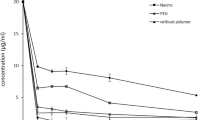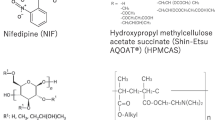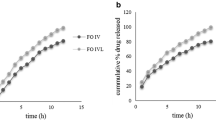Abstract
Different hydroxypropyl methylcellulose (HPMC)/anhydrous dibasic calcium phosphate (ADCP) matrix tablets have been developed aiming to evaluate the influence of both components ratio in the control release of a water-soluble drug (theophylline). In order to characterise the matrix tablets, swelling, buoyancy and dissolution studies have been carried out in different aqueous media (demineralised water, progressive pH medium, simulated gastric fluid, simulated intestinal fluid and simulated colonic fluid). The HPMC/ADCP ratio has turned out to be the determinant in the matrix behaviour: the HPMC characteristic swelling behaviour was modulated, in some cases, by the ADCP characteristic acidic dissolution. When the HPMC/ADCP ratio was ≥0.69, buoyancy, continuous swelling and low theophylline dissolution rate from the matrices (H1, H2 and H3) were observed in all dissolution media. Consequently, these formulations could be adequate as gastro-retentive drug delivery systems. Additionally, HPMC/ADCP ratio ≤0.11 (H5 and H6) induces a pH-dependent drug release which could be applied to design control drug release enteric formulations (with a suitable enteric coating). Finally, a HPMC/ADCP ratio between 0.11 and 0.69 (H4) yield a gastrointestinal controlled drug release, due to its time-dependent buoyancy (7 h) and a total drug delivery in 17 h in simulated colonic fluid.



Similar content being viewed by others
References
Lee BJ, Ryu SG, Cui JH. Formulation and release characteristics of hydroxypropyl methylcellulose matrix tablet containing melatonin. Drug Dev Ind Pharm. 1999;25:493–501.
Sako K, Sawada T, Nakashima H, Yokohama S, Sonobe T. Influence of water soluble fillers in hydroxypropylmethylcellulose matrices on in vitro and in vivo drug release. J Control Release. 2002;81:165–72.
Ebube NK, Jones AB. Sustained release of acetaminophen from a heterogeneous mixture of two hydrophilic non-ionic cellulose ether polymers. Int J Pharm. 2004;272:19–27.
Li CL, Martini LG, Ford JL, Roberts M. The use of hypromellose in oral drug delivery. J Pharm Pharmacol. 2005;57:533–46.
Sung KC, Nixon PR, Skoug JW, Ju TR, Gao P, Topp EM, Patel MV. Effect of formulation variables on drug and polymer release from HPMC-based matrix tablets. Int J Pharm. 1996;142:53–60.
Colombo P, Bettini R, Santi P, Peppas NA. Swellable matrices for controlled drug delivery: gel-layer behaviour, mechanisms and optimal performance. Pharm Sci Technolo Today. 2000;3:198–204.
Lee PI, Peppas NA. Prediction of polymer dissolution in swellable controlled-release systems. J Control Release. 1987;6:207–15.
Narasimhan B, Peppas NA. Molecular analysis of drug delivery systems controlled by dissolution of the polymer carrier. J Pharm Sci. 1997;86:297–304.
Ford JL, Rubinstein ML, Hogan JE. Propranolol hydrochloride and aminophylline release from matrix tablets containing hydroxypropylcellulose. Int J Pharm. 1985;24:339–50.
Feely LC, Davis SS. The influence of polymeric excipients on drug release from Hydroxypropylmethylcellulose matrices. Int J Pharm. 1988;41:83–90.
Hogan JE. Hydroxypropylmethylcellulose sustained release technology. Drug Dev Ind Pharm. 1998;15:975–99.
Hardy IJ, Windberg-Baarup A, Neri C, Byway PV, Booth SW, Fitzpatrick S. Modulation of drug release kinetics from hydroxypropyl methyl cellulose matrix tablets using polyvinyl pyrrolidone. Int J Pharm. 2007;337:246–53.
Gao P, Nixon P, Skoug J. Diffusion in HPMC gels. II Prediction of drug release rates from hydrophilic matrix extended-release dosage forms. Pharm Res. 1995;12:965–71.
Williams III RO, Reynolds TD, Cabelka TD, Sykora MA, Mahaguna V. Investigation of excipient type and level on drug release from controlled release tablets containing HPMC. Pharm Dev Technol. 2002;7:181–93.
Vargas CI, Ghaly ES. Kinetic release of theophylline from hydrophilic swellable matrices. Drug Dev Ind Pharm. 1999;25:1045–50.
Jamzad S, Tutunji L, Fassihi R. Analysis of macromolecular changes and drug release from hydrophilic matrix systems. Int J Pharm. 2005;292:75–85.
Rekhi GS, Nellore RV, Hussain AS, Tillman LG, Malinowski HJ, Augsburger LL. Identification of critical formulation and processing variables for metoprolol tartrate extended-release (ER) matrix tablets. J Control Release. 1999;59:327–42.
Lotfipour F, Nokhodchi A, Saeedi M, Norouzi-Sani S, Sharbafi J, Siahi-Shadbad MR. The effect of hydrophilic and lipophilic polymers and fillers on the release rate of atenolol from HPMC matrices. Farmaco. 2004;59:819–25.
Tavakoli N, Varshosaz J, Dorkoosh F, Motaghi S, Tamaddon L. Development and evaluation of a monolithic floating drug delivery system for acyclovir. Chem Pharm Bull. 2012;60:172–7.
Chaturvedi K, Umadevi S, Vaghani S. Floating matrix dosage form for propranolol hydrochloride based on gas formation technique: development and in vitro evaluation. Sci Pharm. 2010;78:927–39.
Hu L, Li L, Yang X, Liu W, Yang J, Jia Y, Shang Ch XH. Floating matrix dosage form for dextromethorphan hydrobromide based on gas forming technique: in vitro and in vivo evaluation in healthy volunteers. Eur J Pharm Sci. 2011;42:99–105.
Abrahamsson A, Alpsten M, Bakec B, Larsson A, Sjögren J. In vitro and in vivo erosion of two different hydrophilic gel matrix tablets. Eur J Pharm Biopharm. 1998;46:69–75.
Pillay V, Fassihi R. Unconventional dissolution methodologies. J Pharm Sci. 1999;88:843–51.
Maderuelo C, Zarzuelo A, Lanao JM. Critical factors in the release of drugs from sustained release hydrophilic matrices. J Control Release. 2011;154:2–19.
Viridén A, Larsson A, Schagerlöf H, Wittgren B. Model drug release from matrix tablets composed of HPMC with different substituent heterogeneity. Int J Pharm. 2010;401:60–7.
FDA Alert for Healthcare Professionals. Hydromorphone hydrochloride extended-release capsules (marketed as Palladone™), alcohol–palladone™ interaction, 2005.
EMEA, Committee for proprietary medicinal products (CPMP). Note for guidance on quality of modified release products. A: Oral dosage forms; B: Transdermal dosage forms. London: EMEA; 1999
Dow. Using dow excipients for controlled release of drugs in hydrophilic matrix systems. Midland: The Dow Chemical Company; 2006.
Ruiz-Caro R, Veiga MD. Characterization and dissolution study of chitosan freeze-dried systems for drug controlled release. Molecules. 2009;14:4370–86.
The United States Pharmacopeial/The National Formulary, USP 34/NF29. Philadelphia: National Publishing; 2011.
Haupt S, Zioni T, Gati I, Kleinstern J, Rubinstein A. Luminal delivery and dosing considerations of local celecoxib administration to colorectal cancer. Eur J Pharm Sci. 2006;28:204–11.
Wakerly Z, Fell JT, Attwood D, Parkins DA. In vitro evaluation of pectin-based colonic drug delivery systems. Int J Pharm. 1996;129:73–7.
Moore JW, Flanner HH. Mathematical comparison of dissolution profiles. Pharma Tec. 1996;20:64–74.
Shah VP, Tsong Y, Sathe P, Liu J. In vitro dissolution profile comparison-statistics and analysis of the similarity factor, f2. Pharm Res. 1998;15:889–95.
Costa P, Sousa Lobo JM. Modeling and comparison of dissolution profiles. Eur J Pharm Sci. 2001;13:123–33.
Hixson AW, Crowell JH. Dependence of reaction velocity upon surface and agitation. Ind Eng Chem. 1931;239:923–31.
Hopfenberg HB. Controlled release polymeric formulations. In: Paul DR, Harris FW, editors. ACS Symposium Series 33. Washington, DC: American Chemical Society; 1976. p. 26–31.
Katzhendler I, Hofman A, Goldberger A, Friedman M. Modeling of drug release from erodible tablets. J Pharm Sci. 1997;86:110–5.
Higuchi T. Mechanism of sustained-action medication. Theoretical analysis of rate of release of solid drugs dispersed in solid matrices. J Pharm Sci. 1963;52:1145–9.
Korsmeyer RW, Gurny R, Doelker E, Buri P, Peppas NA. Mechanisms of solute release from porous hydrophilic polymers. Int J Pharm. 1983;15:25–35.
Ritger PL, Peppas NA. A simple equation for description of solute release I. Fickian and non-Fickian release from non-swellable devices in the form of slabs, spheres, cylinders or discs. J Control Release. 1987;5:23–6.
Yamashita K, Nakate T, Okimoto K, Ohike A, Tokunaga Y, Ibuki R, Higaki K, Kimura T. Establishment of new preparation method for solid dispersion formulation of tacrolimus. Int J Pharm. 2003;267:79–91.
Morton RC. Calcium phosphate dibasic dehydrate. In: Weller PJ, Sheskey PJ, Rowe RC, editors. Handbook of pharmaceutical excipients. 4th ed. London: Pharmaceutical Press; 2001. p. 96–9.
Sarkar N. Thermal gelation properties of methyl and hydroxypropyl methylcellulose. J Appl Polym Sci. 1979;24:1073–87.
Doelker E. Cellulose derivatives. In: Peppas NA, editor. Advances in polymer science, vol. 107. Berlin: Springer; 1993. p. 199–265.
Haque A, Morris ER. Thermogelation of methylcellulose. Part 1. Molecular structures and processes. Carbohydr Polym. 1993;22:161–73.
Yuasa H, Nakano T, Kanaya Y. Suppression of agglomeration in fluidized bed coating I. Suppression of agglomeration by adding NaCl. Int J Pharm. 1997;158:195–201.
Nakano T, Yuasa H, Kanaya Y. Suppression of agglomeration in fluidized bed coating. III. Hofmeister series in suppression of particle agglomeration. Pharm Res. 1999;16:1616–20.
Pygall SR, Kujawinski S, Timmins P, Melia CD. Mechanisms of drug release in citrate buffered HPMC matrices. Int J Pharm. 2009;370:110–20.
Acknowledgement
Pseidy Luz Mamani Crispin is a recipient of a predoctoral scholarship from the Agencia de Española de Cooperación Internacional y Desarrollo (Spain) to do her Ph.D.
Author information
Authors and Affiliations
Corresponding author
Rights and permissions
About this article
Cite this article
Mamani, P.L., Ruiz-Caro, R. & Veiga, M.D. Matrix Tablets: The Effect of Hydroxypropyl Methylcellulose/Anhydrous Dibasic Calcium Phosphate Ratio on the Release Rate of a Water-Soluble Drug Through the Gastrointestinal Tract I. In Vitro Tests. AAPS PharmSciTech 13, 1073–1083 (2012). https://doi.org/10.1208/s12249-012-9829-9
Received:
Accepted:
Published:
Issue Date:
DOI: https://doi.org/10.1208/s12249-012-9829-9




